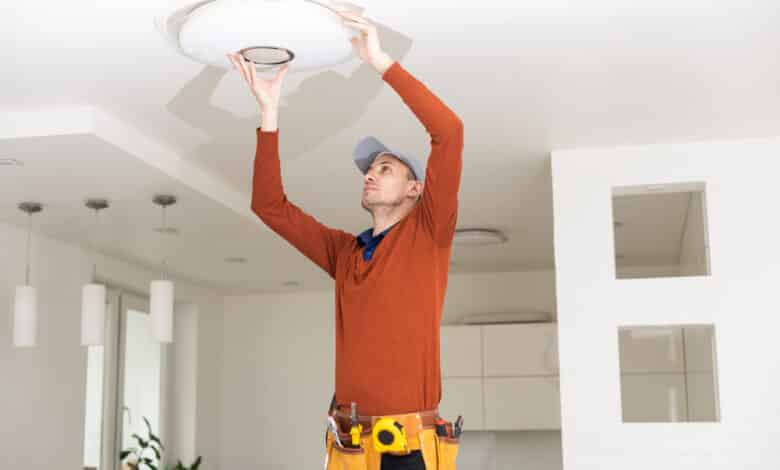
Connecting a lamp is a task that many DIY enthusiasts want to do themselves. Whether it’s fitting a new ceiling light or replacing an existing one, the basics are the same. In this guide, you will find out how to connect a lamp safely and correctly, what tools and materials you need and what you need to bear in mind with the various cables and connections.
Safety first: Always consult a specialist if you are unsure!
Although connecting a lamp can be a feasible task for a skilled DIY enthusiast, it also involves risks. Extreme caution is required with any type of electrical installation. If you have even the slightest doubt about your knowledge or ability to carry out the task safely, you should definitely consult a qualified electrician. This is especially true if you are not familiar with cable color codes, safety regulations or how to work with electricity. A professional will ensure that the work is carried out correctly and safely to avoid risks such as electric shocks or fires. Safety should always come first.
What you need to know before you get started
Before you start connecting your new light, it’s important to know some basic electrical engineering basics. The electrical installation in residential buildings usually consists of various wires that carry electricity. The two most important are the conductor (L) and the neutral conductor (N). The conductor is usually black or brown and carries the current to the lamp, while the neutral conductor, usually blue, carries the current back again. In some installations there is also a protective earth conductor (PE), which is green-yellow and is used for earthing. When connecting a lamp, it is crucial to connect these cables correctly to ensure safe operation.
If you want to connect a lamp, the colors of the cables are an important point of reference. Here are the common color codes for the cables:
- L (conductor) – Black or brown
- N (neutral conductor) – blue
- PE (protective earth) – green-yellow
In older installations, the color codes may differ, so it is important to consult a specialist if you are unsure. Another important point is the luster terminal, which serves as a connecting element between the cables of the lamp and those of the house installation. It enables the various cables to be securely connected together.
Tools and materials
In order to connect your lamp professionally and safely, it is important that you equip yourself with the necessary tools and materials. Here is a helpful list showing you what you should have ready before you get started:
- Voltage tester to make sure there is no current flowing
- Screwdriver, suitable for the screws of your lamp and luster terminal
- Side cutters and / or wire strippers to shorten and strip cables if necessary
- Luster terminals to connect the cables (if none are available)
- Any wall plugs and screws to fix the lamp to the ceiling
- Safety gloves to protect you from electric shocks
Before you start, always switch off the fuse that affects the circuit of your lamp and use a voltage tester to check that there is really no current flowing. Safety should always come first. Make sure you have a stable ladder or a secure stand when working on the ceiling. When drilling to install the light, it is also important to be careful and pay attention to where you drill – avoid areas where there may be wires or pipes. It is also advisable to have a second person to help you, who can hand you tools or hold the lamp.
Instructions: Connecting the lamp step by step
Connecting a lamp is a process that can be broken down into several clear steps to get you safely to your destination step by step. Here you’ll find detailed instructions to guide you through every aspect of the process, from preparation to the final check, to make sure everything goes smoothly and safely:
- Before you start work, it’s crucial to locate the correct fuse in the fuse box and switch it off. In many cases, the lighting is on its own circuit.
- Once you have deactivated the correct fuse, use a voltage tester to ensure that there is actually no current flowing. This important step guarantees your safety by protecting you from potential electric shocks during the installation of the lamp.
- Dismantle the old lamp, if present. Pay attention to how the cables are connected to repeat this for the new lamp. Use your smartphone to take a photo of the existing connection. This way, you can easily check if you are unsure or reconnect the old lamp if it doesn’t work with the new one.
- Prepare the cables for your new lamp. If necessary, shorten the cables to a suitable length and strip about 1 cm of insulation from the ends.
- Now comes the time to connect the cables of your lamp to those of the house installation. It is essential to pay attention to the correct assignment: Connect L to L, i.e. the black or brown cable of your lamp to the cable of the same color in your installation. The same applies to N, the blue cable, which is connected to the corresponding blue cable. And don’t forget PE, the green/yellow earthing cable, which must also be connected to the corresponding green/yellow cable.
- Attach the lamp to the ceiling by screwing or otherwise fixing it, depending on the lamp’s installation instructions.
- Check that all connections are tight and secure and then switch the fuse back on.
- Test the lamp by pressing the light switch.
If you have a lamp with more cables than connections, for example a lamp with 3 cables and 2 connections, then it is usually a lamp that is intended for a circuit with a separate circuit for the light source and possibly a separate light or fan. In such cases, you should study the installation instructions for the lamp carefully or consult a specialist.
Tips for connecting a lamp with multiple cables
Connecting a lamp with multiple cables can be a tricky task, especially if you are not familiar with different types of lights and installations. Here are some tips that can help you:
- Study the lamp’s installation instructions to find out what each cable is for. The installation instructions often explain in detail how the cables should be connected. For lamps with several cables, special instructions may be included, e.g. for lamps with different lighting modes or additional functions such as fans.
- For a lamp with four cables, you may come across an additional control line for dimming functions or an independent circuit. It’s important to identify the function of each wire before you start connecting.
- If you are unsure about any step, don’t hesitate to consult an experienced electrician. It’s always better to be safe than sorry, especially with electrical installations.
With a bit of know-how and the right tools, connecting a lamp is perfectly feasible for many DIY enthusiasts. But hey, safety first! So, if you’re not quite sure, don’t be afraid to ask a professional for advice. With care and attention, you can fill your rooms with light and enjoy the results of your work.
Now you can see the light
Now that you know the steps for connecting a lamp, you should be able to tackle this project with confidence. Always remember that safety comes first. If you are unsure, switch off the fuse and use a voltage tester to check whether the circuit is really de-energized. If you encounter any problems or the connection proves to be more complicated than expected, don’t hesitate to consult a specialist. However, with patience and care, the installation of your new lamp will certainly be a success and your rooms will shine in a new light.



